Laboratories
- Back
- Top > Laboratories > Medicine in Growth and Aging > Obstetrics and Gynecology
Medicine in Growth and AgingObstetrics and Gynecology
Introduction
Our Department is a leading center of clinical medicine and academic research in the Tokai region of Japan. Major research themes are immunotherapy of ovarian cancer, medical applications of plasma, malignant potential of gestational trophoblastic diseases, the mechanism for placental development, effect of molecular hydrogen against perinatal brain injury, congenital diaphragmatic hernia, anti-mullerian hormone, follicle maturation, and endometriosis. We welcome doctors to join to our members, and hope to work or research with us.
Research Projects
1. Gynecologic Oncology
i) Establishment of patient-derived xenograft models and analysis of tumor-infiltrating lymphocytes in malignant gynecologic tumors for development of tailor-made tumor immunotherapy
Our department aims to investigate evidenced-based gynecologic cancer therapy, repeating basic research and translational research. The department is focused on developing not only more effective immunotherapies but also immunological method for suppression of recurrence or for cancer prevention.
Tumor-infiltrating lymphocytes (TILs) are known to mediate potent anti-tumor activity. It becomes important to understand what characterizes a successful anti-tumor T-cell response. To discern whether targetable neoantigens exist in gynecologic cancer, we perform ex vivo expansion of TILs and analyze TILs.
Recently, the patient-derived-xenograft (PDX) models have been used in the oncologic field to develop new therapeutic agents, which preserve tumor microenvironment and tumor characteristics, and well reflect patient's histological features. We try to establish novel PDX models of gynecologic cancer.
ii) Development of tumor-associated antigens-targeted cancer immunotherapy against refractory ovarian cancer
Compared with other epithelial ovarian carcinoma subtypes, ovarian clear cell carcinoma (OCCC) has been recognized to show chemoresistance. Therefore, new treatment modalities are required for patients with OCCC that is refractory to chemotherapy.
Glypican-3 (GPC3) is useful not only as a novel tumor marker, but also as an oncofetal antigen for immunotherapy. It is specifically overexpressed in hepatocellular carcinoma (HCC). Previous studies demonstrated that GPC3 was also overexpressed in several malignant tumors, including OCCC. We performed a phase II trial with a GPC3-derived peptide vaccine in OCCC patients. We evaluate the clinical and immunological effects of vaccination. (1-6)

iii)Treatment application of Indirect Nonequilibrium Atmospheric Pressure Plasma on Anti-proliferative Activity against Ovarian Cancer Cells
Plasma, commonly employed in physical sciences is essentially an ionized gas in which a fraction of the atoms or molecules are ionized. Plasma as an active ionized medium sustained by supply of energy containing free charges, free radicals, excited molecules and energetic photons can induce processes usually obtained through chemical treatment or radiotherapy. In accordance with renovative technical development, the new generation of plasma under nonequilibrium atmospheric pressure plasmas (NEAPPs) has actually become practical use. NEAPP has recently been in the limelight as a novel medical practice. There has been therapeutic trial applied in the field of tissue sterilization, blood coagulation, wound-healing promotion, and dental breaching. Additionally, it was recently reported that plasma has exerted anti-proliferative effect on a variety of cancer cells, inducing apoptosis, which in known to programmed cell death. Moreover, instead of a direct effect on the cells, the exposure to medium treated with plasma separated from cells (indirect plasma) showed decreased cell proliferation of mammalian breast epithelial cells via generation of ROS in the medium. (7-9)
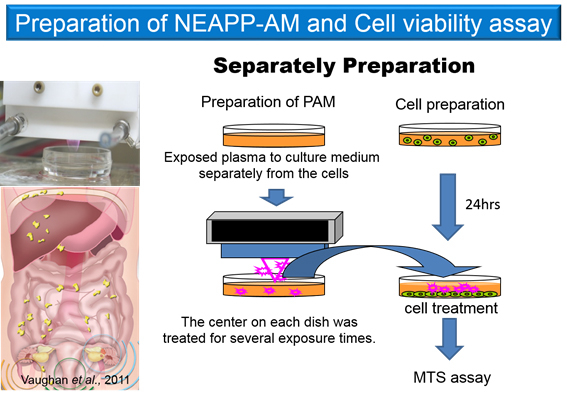
Reference (Gynecologic Oncology)
- Significant clinical response of progressive recurrent ovarian clear cell carcinoma to glypican-3-derived peptide vaccine therapy: two case reports. Suzuki S., Shibata K., Kikkawa F., Nakatsura T. Hum Vaccin Immunother 2014; 10: 338-343.
- GPC3 expression in mouse ovarian cancer induces GPC3specific T cell-mediated immune response through M1 macrophages and suppresses tumor growth. Luo C., Shibata K., Suzuki S., Kajiyama H., Senga T., Koya Y., Daimon M., Yamashita M., Kikkawa F. Oncol Rep 2014; 32: 913-921.
- Diagnostic utility of CD117, CD133, SALL4, OCT4, TCL1 and glypican-3 in malignant germ cell tumors of the ovary. Trinh D. T., Shibata K., Hirosawa T., Umezu T., Mizuno M., Kajiyama H., Kikkawa F. J Obstet Gynaecol Res 2012; 38: 841-848.
- Glypican-3 could be an effective target for immunotherapy combined with chemotherapy against ovarian clear cell carcinoma. Suzuki S., Yoshikawa T., Hirosawa T., Shibata K., Kikkawa F., Akatsuka Y., Nakatsura T. Cancer Sci 2011; 102: 1622-1629.
- Glypican-3 expression predicts poor clinical outcome of patients with early-stage clear cell carcinoma of the ovary. Umezu T., Shibata K., Kajiyama H., Yamamoto E., Nawa A., Kikkawa F. J Clin Pathol 2010; 63: 962-966.
- Growth-suppressing function of glypican-3 (GPC3) via insulin like growth factor II (IGF-II) signaling pathway in ovarian clear cell carcinoma cells. Sakurai M., Shibata K., Umezu T., Kajiyama H., Yamamoto E., Ino K., Nawa A., Kikkawa F. Gynecol Oncol 2010; 119: 332-336.
- Effect of indirect nonequilibrium atmospheric pressure plasma on anti-proliferative activity against chronic chemo-resistant ovarian cancer cells in vitro and in vivo. Utsumi F., Kajiyama H., Nakamura K., Tanaka H., Mizuno M., Ishikawa K., Kondo H., Kano H., Hori M., Kikkawa F. PLoS One 2013; 8: e81576.
- Selective cytotoxicity of indirect nonequilibrium atmospheric pressure plasma against ovarian clear-cell carcinoma. Utsumi F., Kajiyama H., Nakamura K., Tanaka H., Hori M., Kikkawa F. Springerplus 2014; 3: 398.
- Variable susceptibility of ovarian cancer cells to non-thermal plasma-activated medium. Utsumi F., Kajiyama H., Nakamura K., Tanaka H., Mizuno M., Toyokuni S., Hori M., Kikkawa F. Oncol Rep 2016; 35: 3169-3177.
2. Gestational Trophoblastic diseases
i) GnT-IVa and C2GnTexpression in trophoblasts of Gestational trophoblastic diseases (GTDs)
Gestational trophoblastic diseases (GTDs) are related to trophoblasts and human chorionic gonadotropin (hCG) is secreted by GTDs as well as normal placentas. However, hyperglycosylated hCG (H-hCG), which is different from regular hCG, is highly secreted by choriocarinoma. H-hCG is used as an indicator of choriocarcinoma activity and enhances invasiveness of trophoblasts. N-acetylglucosaminyltransferase IV(GnT-IV)or Core 2 β1, 6-N acetylglcosaminyl transferase (C2GnT) catalyzes produces H-hCG. We analyze the role of GnT-IVa and C2GnT in choriocarcinoma (1).
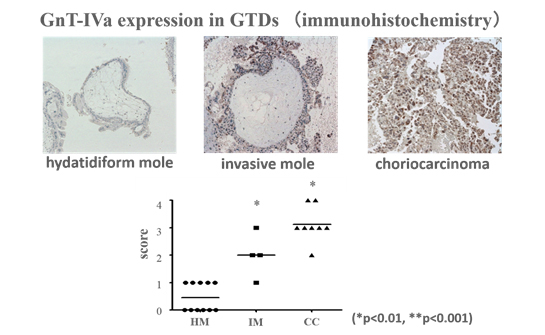
ii) Identification of causative pregnancy of gestational trophoblastic neoplasia
Gestational trophoblastic neoplasias (GTNs) are tumors that arise from trophoblasts such as invasive mole, choriocarcinoma, placental site trophoblastic tumor (PSTT) and epithelioid trophoblastic tumor. Invasive mole is a pre-malignant disease which occurs in 10–20% cases of hydatidiform mole. Choriocarcinoma and PSTT are malignant tumors which arise from the trophoblasts of any kind of pregnancy, including hydatidiform mole. It has been shown that the causative pregnancy of GTNs is not necessarily the immediately antecedent pregnancy using DNA analysis. To identify the causative pregnancies, we perform DNA analysis for 15 short tandem repeats (STRs) using a commercially released kit (2).
Fig. STRs analysis of non-gestational trophoblastic disease (B: blood, T: tumor)
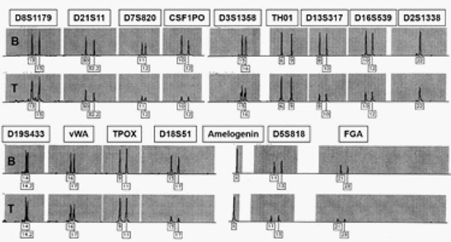
Reference (Gestational Trophoblastic Diseases)
- High expression of N-acetylglucosaminyltransferase IVa promotes invasion of choriocarcinoma. Niimi K., Yamamoto E., Fujiwara S., Shinjo K., Kotani T., Umezu T., Kajiyama H., Shibata K., Ino K., Kikkawa F. Br J Cancer 2012; 107: 1969-1977.
- Identification of causative pregnancy of gestational trophoblastic neoplasia diagnosed during pregnancy by short tandem repeat analysis. Yamamoto E., Niimi K., Shinjo K., Yamamoto T., Fukunaga M., Kikkawa F. Gynecol Oncol Case Rep 2014; 9: 3-6.
3. Obstetrics
ⅰ) Study of the mechanism for placental development
Preeclampsia is a syndrome characterized by the onset of hypertension and either proteinuria or end-organ dysfunction after 20 weeks of gestation. Abnormalities in the development of placental vasculature early in pregnancy may result in relative placental under perfusion/hypoxia/ischemia, which then leads to release of antiangiogenic factors into the maternal circulation that alter maternal systemic endothelial function and cause hypertension and other manifestations of the disease. Inversely, excessive extravillous trophoblastic invasion can cause placenta accreta/increta/percreta. The molecular basis for abnormal placental development and placental dysregulation of these pathogenic factors remains unknown. We investigate the mechanism for early placental vascular development using primary extravillous trophoblast (EVT) and HTR-8/SVneo cells. Some of our results are as follows:
1. EVT increased their invasive function as a result of decreasing expression of transmembrane endoglin (1).
2. Sphingosine-1-phosphate, which is a bioactive lipid and is reported to be correlated with cancer invasion might play a role in the onset of labor via the induction of prostaglandin-endoperoxide synthase -2 (2).
3. Activator protein-2 may suppress trophoblast migration and invasion, thus leading to a shallow placentation in preeclampsia (3).
ⅱ) Study of the fetal lung development and maturation
Congenital diaphragmatic hernia (CDH) is a defect of the diaphragm that allows the abdominal contents to ascend into the thoracic cavity. Despite the progress in prenatal diagnosis and postnatal care, CDH remains associated with a high rate of mortality. The lung hypoplasia and persistent pulmonary hypertension (PH) that is associated with this disorder are the key determinants of mortality. To examine the underlying pathogenesis of CDH, we used nitrofen-induced CDH rat model, as it is remarkably similar to human CDH. According to our study using this rat model, we reported as follows:
1. Amniotic LBC is useful for predicting lung hypoplasia (4).
2. Amniotic lipocalin-2 can be a potentially useful biomarker for lung hypoplasia (5).
3. Antenatal Saireito can improve fetal pulmonary hypoplasia and pulmonary vascular remodeling, as a result, can improve respiratory function (6).
Fig. The macroscopic findings of diaphragm of rat model.

Control
CDH
iii) Study of perinatal brain injury
We also study with the aim of establishment of novel patogenesis and new treatment of perinatal brain injury. Now, molecular hydrogen (H2) has been widely used in medical applications as a safe and effective treatment without any known side effects. The first article on the effects of H2 was reported on cerebral infarction in Nature 2007. Our previous work has indicated that maternal intake of H2 increased the H2 concentration in the fetal head and relieved fetal hippocampal damage in an in utero ischemia–reperfusion rat model (7). Based on previous findings, we investigate whether maternal intake of H2 offers protection against fetal brain injury induced by inflammation or oxidative stress in a mouse model and also study the molecular target of H2 (8,9,10).
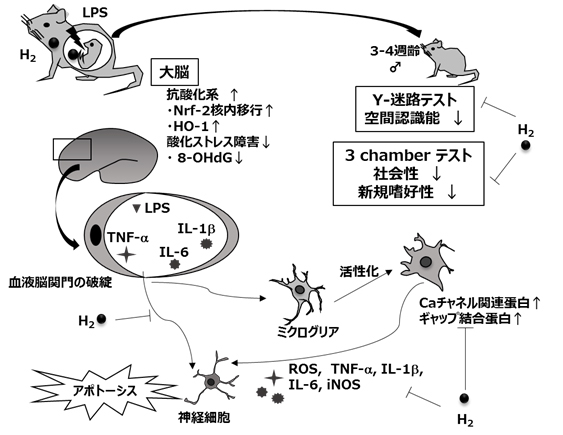
Fig. The effect of molecular hydrogen on the perinatal brain injury
Reference (Obstetrics)
- The loss of endoglin promotes the invasion of extravillous trophoblasts.Mano Y., Kotani T., Shibata K., Matsumura H., Tsuda H., Sumigama S., Yamamoto E., Iwase A., Senga T., Kikkawa F. Endocrinology 2011; 152: 4386-4394.
- Increased expression of sphingosine kinase in the amnion during labor. Erkhembaatar L. O., Kotani T., Sumigama S., Tsuda H., Mano Y., Hua L., Hasegawa Y., Wang J., Sugiyama C., Nakahara T., Iwase A., Kikkawa F. Placenta 2013; 34: 353-359.
- Activator protein-2 impairs the invasion of a human extravillous trophoblast cell line. Kotani T., Iwase A., Ino K., Sumigama S., Yamamoto E., Hayakawa H., Nagasaka T., Itakura A., Nomura S., Kikkawa F. Endocrinology 2009; 150: 4376-4385.
- Amniotic lamellar body count and congenital diaphragmatic hernia in humans and in a rat model.Watanabe Y., Tsuda H., Kotani T., Sumigama S., Mano Y., Hayakawa M., Sato Y., Kikkawa F. Pediatr Res 2013; 73: 344-348.
- Lipocalin 2 as a new biomarker for fetal lung hypoplasia in congenital diaphragmatic hernia. Tsuda H., Kotani T., Nakano T., Imai K., Hirako S., Li H., Kikkawa F. Clin Chim Acta 2016; 462: 71-76.
- Antenatal Saireito (TJ-114) Can Improve Pulmonary Hypoplasia and Pulmonary Vascular Remodeling in Nitrofen-Induced Congenital Diaphragmatic Hernia. Hirako S., Tsuda H., Kotani T., Sumigama S., Mano Y., Nakano T., Imai K., Li H., Toyokuni S., Kikkawa F. Phytother Res 2016; 30: 1474-1480.
- Maternal molecular hydrogen administration ameliorates rat fetal hippocampal damage caused by in utero ischemia-reperfusion. Mano Y., Kotani T., Ito M., Nagai T., Ichinohashi Y., Yamada K., Ohno K., Kikkawa F., Toyokuni S. Free Radic Biol Med 2014; 69: 324-330.
- Neuroprotective potential of molecular hydrogen against perinatal brain injury via suppression of activated microglia. Imai K., Kotani T., Tsuda H., Mano Y., Nakano T., Ushida T., Li H., Miki R., Sumigama S., Iwase A., Hirakawa A., Ohno K., Toyokuni S., Takeuchi H., Mizuno T., Suzumura A., Kikkawa F. Free Radic Biol Med 2016; 91: 154-163.
- Maternal molecular hydrogen administration on lipopolysaccharide-induced mouse fetal brain injury. Nakano T., Kotani T., Mano Y., Tsuda H., Imai K., Ushida T., Li H., Miki R., Sumigama S., Sato Y., Iwase A., Hirakawa A., Asai M., Toyokuni S., Kikkawa F. J Clin Biochem Nutr 2015; 57: 178-182.
- Maternal molecular hydrogen treatment attenuates lipopolysaccharide-induced rat fetal lung injury. Hattori Y., Kotani T., Tsuda H., Mano Y., Tu L., Li H., Hirako S., Ushida T., Imai K., Nakano T., Sato Y., Miki R., Sumigama S., Iwase A., Toyokuni S., Kikkawa F. Free Radic Res 2015; 49: 1026-1037.
4. Reproductive Biology and Medicine
i) Regulatory controls of follicle maturation by proliferating granulosa cells
A greater understanding of the mechanisms of folliculogenesis and steroidogenesis may lead to improvements in the success rates of assisted reproductive technologies or the development of treatments for reproductive disorders. Challenging to this issue, we focused on proliferation and apoptotic mechanism of granulosa cells (GCs), and signals form GCs to oocytes to elucidate the GCs regulation of follicle maturation. We characterized the role of tumor suppressor, phosphatase and tensin homologue deleted on chromosome 10 (PTEN) on GCs proliferation and differentiation (1). Moreover, we have established a human non-luteinized granulosa cell line (HGrC1) which is a highly beneficial tool for investigation of follicle development (2).
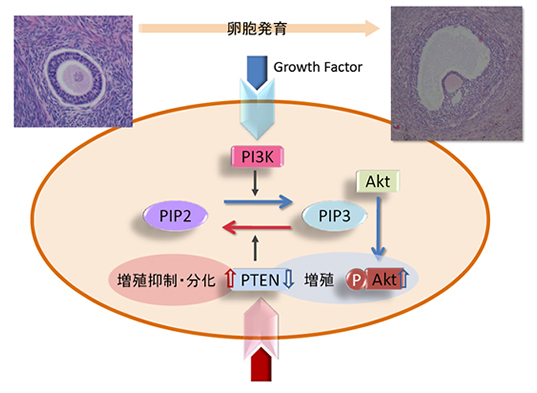
ii) Assessment of ovarian reserve
Ovarian reserve (OR) has become indispensable for the better understanding of reproductive potential. Measurement of the serum anti-Mülerian hormone (AMH) level allows quantitative evaluation of OR. We study the effect of ovarian operation and chemotherapy on OR by determination of AMH levels (3, 4).
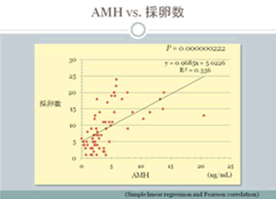
iii) Understandings of pathogenesis of endometriosis and development of new treatments
We investigate pathogenesis and development of endometriosis by using human samples and animal models. Our goal is developing the novel treatment for endometriosis (5).
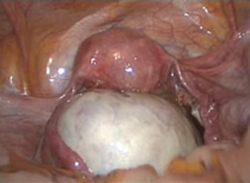
Reference (Reproductive Biology and Medicine)
- Insulin attenuates the insulin-like growth factor-I (IGF-I)-Akt pathway, not IGF-I-extracellularly regulated kinase pathway, in luteinized granulosa cells with an increase in PTEN. Iwase A., Goto M., Harata T., Takigawa S., Nakahara T., Suzuki K., Manabe S., Kikkawa F. J Clin Endocrinol Metab 2009; 94: 2184-2191.
- Establishment of a human nonluteinized granulosa cell line that transitions from the gonadotropin-independent to the gonadotropin-dependent status. Bayasula, Iwase A., Kiyono T., Takikawa S., Goto M., Nakamura T., Nagatomo Y., Nakahara T., Kotani T., Kobayashi H., Kondo M., Manabe S., Kikkawa F. Endocrinology 2012; 153: 2851-2860.
- The post-operative decline in serum anti-Mullerian hormone correlates with the bilaterality and severity of endometriosis. Hirokawa W., Iwase A., Goto M., Takikawa S., Nagatomo Y., Nakahara T., Bayasula B., Nakamura T., Manabe S., Kikkawa F. Hum Reprod 2011; 26: 904-910.
- One-year follow-up of serum antimullerian hormone levels in patients with cystectomy: are different sequential changes due to different mechanisms causing damage to the ovarian reserve? Sugita A., Iwase A., Goto M., Nakahara T., Nakamura T., Kondo M., Osuka S., Mori M., Saito A., Kikkawa F. Fertil Steril 2013; 100: 516-522.e513.
- The ferroimmunomodulatory role of ectopic endometriotic stromal cells in ovarian endometriosis. Kobayashi H., Yamashita Y., Iwase A., Yoshikawa Y., Yasui H., Kawai Y., Uchida K., Uno N., Akatsuka S., Takahashi T., Kikkawa F., Toyokuni S. Fertil Steril 2012; 98: 415-422 e411-412.
Faculty Members
| Faculty | Position | Department |
|---|---|---|
| Hiroaki KAJIYAMA | Professor | Graduate School of Medicine Program in Integrated Medicine |
| Tomomi KOTANI | Associate Professor | Nagoya University Hospital Obstetrics and Gynecology |
| Maki GOTO | Lecturer of hospital | Nagoya University Hospital Obstetrics and Gynecology |
| Shiro SUZUKI | Lecturer | Nagoya University Hospital Obstetrics and Gynecology |
| Satoko OSUKA | Lecturer | Center for Maternal-Neonatal Care, University Hospital |
| Tomoko NAKAMURA | Lecturer | Nagoya University Hospital Obstetrics and Gynecology |
| Tomoko NAKANO | Lecturer of hospital | Nagoya University Hospital Obstetrics and Gynecology |
| Kaoru NIIMI | Assistant Professor | Nagoya University Hospital Obstetrics and Gynecology |
| Kenji IMAI | Assistant Professor | Nagoya University Hospital Obstetrics and Gynecology |
| Fumi UTSUMI | Assistant Professor | Nagoya University Hospital Obstetrics and Gynecology |
| Kimihiro NISHINO | Assistant Professor | Nagoya University Hospital Obstetrics and Gynecology |
| Kayo FUJIKAKE | Assistant Professor | Center for Maternal-Neonatal Care, University Hospital |
| Nobuhisa YOSHIKAWA | Assistant Professor of hospital | Postgraduate-c-t |
| Tomohiko MURASE | Assistant Professor of hospital | Nagoya University Hospital Obstetrics and Gynecology |
| Yoshiki IKEDA | Designated Assistant Professor | Graduate School of Medicine Program in Integrated Medicine |
| Yoshinori MORIYAMA | Assistant Professor of hospital | Nagoya University Hospital Obstetrics and Gynecology |
Bibliography
- 2016
- Yoshikawa N., Kajiyama H., Nakamura K., Utsumi F., Niimi K., Mitsui H., Sekiya R., Suzuki S., Shibata K., Callen D., Kikkawa F. PRIMA-1MET induces apoptosis through accumulation of intracellular reactive oxygen species irrespective of p53 status and chemo-sensitivity in epithelial ovarian cancer cells. Oncol Rep 2016; 35: 2543-2552.
- Yoshida K., Kajiyama H., Utsumi F., Mitsui H., Shibata K., Kikkawa F. Radiotherapy for persistent malignant transformation from mature cystic teratoma of the ovary. J Obstet Gynaecol Res 2016; 42: 584-588.
- Utsumi F., Kajiyama H., Nakamura K., Tanaka H., Mizuno M., Toyokuni S., Hori M., Kikkawa F. Variable susceptibility of ovarian cancer cells to non-thermal plasma-activated medium. Oncol Rep 2016; 35: 3169-3177.
- Tsuda H., Kotani T., Sumigama S., Mano Y., Nakano T., Hua L., Kikkawa F. Relationship between the cortisol levels in umbilical cord blood and neonatal RDS/TTN in twin pregnancies. J Matern Fetal Neonatal Med 2016; 29: 2151-2156.
- Tsuda H., Kotani T., Sumigama S., Mano Y., Hayakawa H., Kikkawa F. Efficacy and safety of daikenchuto (TJ-100) in pregnant women with constipation. Taiwan J Obstet Gynecol 2016; 55: 26-29.
- Tsuda H., Kotani T., Nakano T., Imai K., Hirako S., Li H., Kikkawa F. Lipocalin 2 as a new biomarker for fetal lung hypoplasia in congenital diaphragmatic hernia. Clin Chim Acta 2016; 462: 71-76.
- Tamauchi S., Kajiyama H., Sakata J., Sekiya R., Suzuki S., Mizuno M., Utsumi F., Niimi K., Kotani T., Shibata K., Kikkawa F. Oncologic and obstetric outcomes of early stage cervical cancer with abdominal radical trachelectomy: Single-institution experience. J Obstet Gynaecol Res 2016.
- Nosaka K., Shibata K., Utsumi F., Yoshida K., Niimi K., Sekiya R., Suzuki S., Kajiyama H., Kikkawa F. Feasibility and benefit of concurrent chemoradiotherapy for elderly patients with uterine cervical cancer. Tumori 2016: 0.
- Muraoka A., Tsuda H., Kotani T., Kikkawa F. Severe Hemoperitoneum During Pregnancy with Obstructed Hemivagina and Ipsilateral Renal Anomaly Syndrome: A Case Report. J Reprod Med 2016; 61: 290-294.
- Mori M., Iwase A., Osuka S., Kondo M., Nakamura T., Nakahara T., Goto M., Kikkawa F. Choosing the optimal therapeutic strategy for placental polyps using power Doppler color scoring: Transarterial embolization followed by hysteroscopic resection or expectant management? Taiwan J Obstet Gynecol 2016; 55: 534-538.
- Maeda O., Miyata-Takata T., Shibata K., Kajiyama H., Mizuno M., Tamakoshi K., Shimoyama Y., Nakamura S., Kikkawa F. Comparison of prognoses according to non-positive and positive spectrin alphaII expression detected immunohistochemically in epithelial ovarian carcinoma: a retrospective study. Cancer Med 2016; 5: 1081-1092.
- Kondo M., Osuka S., Iwase A., Nakahara T., Saito A., Bayasula, Nakamura T., Goto M., Kotani T., Kikkawa F. Increase of kisspeptin-positive cells in the hypothalamus of a rat model of polycystic ovary syndrome. Metab Brain Dis 2016; 31: 673-681.
- Kan M., Yamamoto E., Niimi K., Tamakoshi K., Sekiya Y., Nishino K., Ino K., Kikkawa F. Gestational Trophoblastic Neoplasia and Pregnancy Outcome After Routine Second Curettage for Hydatidiform Mole: A Retrospective Observational Study. J Reprod Med 2016; 61: 373-379.
- Iwase A., Osuka S., Nakamura T., Kato N., Takikawa S., Goto M., Kikkawa F. Usefulness of the Ultrasensitive Anti-Mullerian Hormone Assay for Predicting True Ovarian Reserve. Reprod Sci 2016; 23: 756-760.
- Iwase A., Nakamura T., Kato N., Goto M., Takikawa S., Kondo M., Osuka S., Mori M., Kikkawa F. Anti-Mullerian hormone levels after laparoscopic cystectomy for endometriomas as a possible predictor for pregnancy in infertility treatments. Gynecol Endocrinol 2016; 32: 293-297.
- Ishida C., Mori M., Nakamura K., Tanaka H., Mizuno M., Hori M., Iwase A., Kikkawa F., Toyokuni S. Non-thermal plasma prevents progression of endometriosis in mice. Free Radic Res 2016: 1-9.
- Ishida C., Iwase A., Osuka S., Goto M., Takikawa S., Nakamura T., Kotani T., Kikkawa F. Serum pentraxin 3 as a possible marker for mature cystic teratomas. Gynecol Endocrinol 2016: 1-4.
- Imai K., Kotani T., Tsuda H., Mano Y., Nakano T., Ushida T., Li H., Miki R., Sumigama S., Iwase A., Hirakawa A., Ohno K., Toyokuni S., Takeuchi H., Mizuno T., Suzumura A., Kikkawa F. Neuroprotective potential of molecular hydrogen against perinatal brain injury via suppression of activated microglia. Free Radic Biol Med 2016; 91: 154-163.
- Hirako S., Tsuda H., Kotani T., Sumigama S., Mano Y., Nakano T., Imai K., Li H., Toyokuni S., Kikkawa F. Antenatal Saireito (TJ-114) Can Improve Pulmonary Hypoplasia and Pulmonary Vascular Remodeling in Nitrofen-Induced Congenital Diaphragmatic Hernia. Phytother Res 2016; 30: 1474-1480.
- 2015
- Wang J., Kotani T., Tsuda H., Mano Y., Sumigama S., Li H., Komatsu K., Miki R., Maruta E., Niwa Y., Mitsui T., Yoshida S., Yamashita M., Tamakoshi K., Kikkawa F. Is the serum l-arginine level during early pregnancy a predictor of pregnancy-induced hypertension? J Clin Biochem Nutr 2015; 57: 74-81.
- Utsumi F., Kajiyama H., Sakata J., Higashi M., Niimi K., Sekiya R., Mitsui H., Suzuki S., Umezu T., Mizuno M., Yamamoto E., Shibata K., Kikkawa F. Opioid needs of terminally ill patients with gynecologic malignancies. Int J Clin Oncol 2015; 20: 405-410.
- Tsuda H., Kotani T., Sumigama S., Mano Y., Kawabata I., Takahashi Y., Iwagaki S., Hirakawa A., Kikkawa F. Amniotic lamellar body count: predicting and distinguishing neonatal respiratory complications in twin pregnancies. Clin Chim Acta 2015; 441: 75-78.
- Tsuda H., Kotani T., Sumigama S., Mano Y., Hua L., Kikkawa F. Impact of warning bleeding on the cortisol level in the fetus and neonatal RDS/TTN in cases of placenta previa. J Matern Fetal Neonatal Med 2015; 28: 1057-1060.
- Tsuda H., Hirakawa A., Kotani T., Sumigama S., Mano Y., Nakano T., Imai K., Kawabata I., Takahashi Y., Iwagaki S., Kikkawa F. Risk assessment for neonatal RDS/TTN using gestational age and the amniotic lamellar body count in twin pregnancies. Clin Chim Acta 2015; 451: 301-304.
- Nakano T., Kotani T., Mano Y., Tsuda H., Imai K., Ushida T., Li H., Miki R., Sumigama S., Sato Y., Iwase A., Hirakawa A., Asai M., Toyokuni S., Kikkawa F. Maternal molecular hydrogen administration on lipopolysaccharide-induced mouse fetal brain injury. J Clin Biochem Nutr 2015; 57: 178-182.
- Nakamura T., Iwase A., Bayasula B., Nagatomo Y., Kondo M., Nakahara T., Takikawa S., Goto M., Kotani T., Kiyono T., Kikkawa F. CYP51A1 induced by growth differentiation factor 9 and follicle-stimulating hormone in granulosa cells is a possible predictor for unfertilization. Reprod Sci 2015; 22: 377-384.
- Mori M., Ito F., Shi L., Wang Y., Ishida C., Hattori Y., Niwa M., Hirayama T., Nagasawa H., Iwase A., Kikkawa F., Toyokuni S. Ovarian endometriosis-associated stromal cells reveal persistently high affinity for iron. Redox Biol 2015; 6: 578-586.
- Mizuno M., Kajiyama H., Shibata K., Mizuno K., Kawai M., Nagasaka T., Kikkawa F. Prognostic value of histological type in stage IV ovarian carcinoma: a retrospective analysis of 223 patients. Br J Cancer 2015; 112: 1376-1383.
- Kato N., Iwase A., Sugita A., Goto M., Nakahara T., Nakamura T., Kondo M., Osuka S., Mori M., Saito A., Kikkawa F. Anti-Mullerian hormone as a possible predictor of fecundability in subfertile women over 38 years: a retrospective cohort study. Gynecol Endocrinol 2015; 31: 22-25.
- Iwase A., Nakamura T., Nakahara T., Goto M., Kikkawa F. Anti-Mullerian hormone and assessment of ovarian reserve after ovarian toxic treatment: a systematic narrative review. Reprod Sci 2015; 22: 519-526.
- Hattori Y., Kotani T., Tsuda H., Mano Y., Tu L., Li H., Hirako S., Ushida T., Imai K., Nakano T., Sato Y., Miki R., Sumigama S., Iwase A., Toyokuni S., Kikkawa F. Maternal molecular hydrogen treatment attenuates lipopolysaccharide-induced rat fetal lung injury. Free Radic Res 2015; 49: 1026-1037.
- Adachi M., Mizuno M., Mitsui H., Kajiyama H., Suzuki S., Sekiya R., Utsumi F., Shibata K., Taniguchi T., Kawaguchi K., Yokoi K., Kikkawa F. The prognostic impact of pulmonary metastasectomy in recurrent gynecologic cancers: a retrospective single-institution study. Nagoya J Med Sci 2015; 77: 363-372.
- 2014
- Yamamoto E., Niimi K., Shinjo K., Yamamoto T., Fukunaga M., Kikkawa F. Identification of causative pregnancy of gestational trophoblastic neoplasia diagnosed during pregnancy by short tandem repeat analysis. Gynecol Oncol Case Rep 2014; 9: 3-6.
- Utsumi F., Kajiyama H., Nakamura K., Tanaka H., Hori M., Kikkawa F. Selective cytotoxicity of indirect nonequilibrium atmospheric pressure plasma against ovarian clear-cell carcinoma. Springerplus 2014; 3: 398.
- Tsuda H., Kotani T., Sumigama S., Mano Y., Hua L., Hayakawa H., Hayakawa M., Sato Y., Kikkawa F. Effect of placenta previa on neonatal respiratory disorders and amniotic lamellar body counts at 36-38weeks of gestation. Early Hum Dev 2014; 90: 51-54.
- Sumigama S., Sugiyama C., Kotani T., Hayakawa H., Inoue A., Mano Y., Tsuda H., Furuhashi M., Yamamuro O., Kinoshita Y., Okamoto T., Nakamura H., Matsusawa K., Sakakibara K., Oguchi H., Kawai M., Shimoyama Y., Tamakoshi K., Kikkawa F. Uterine sutures at prior caesarean section and placenta accreta in subsequent pregnancy: a case-control study. Bjog 2014; 121: 866-874; discussion 875.
- Shinjo K., Yamashita Y., Yamamoto E., Akatsuka S., Uno N., Kamiya A., Niimi K., Sakaguchi Y., Nagasaka T., Takahashi T., Shibata K., Kajiyama H., Kikkawa F., Toyokuni S. Expression of chromobox homolog 7 (CBX7) is associated with poor prognosis in ovarian clear cell adenocarcinoma via TRAIL-induced apoptotic pathway regulation. Int J Cancer 2014; 135: 308-318.
- Niimi K., Murakumo Y., Watanabe N., Kato T., Mii S., Enomoto A., Asai M., Asai N., Yamamoto E., Kajiyama H., Shibata K., Kikkawa F., Takahashi M. Suppression of REV7 enhances cisplatin sensitivity in ovarian clear cell carcinoma cells. Cancer Sci 2014; 105: 545-552.
- Nakahara T., Iwase A., Mori M., Kondo M., Goto M., Kikkawa F. Pelvic tuberculous granuloma successfully treated with laparoscopy to preserve fertility: a case report and review of the published work. J Obstet Gynaecol Res 2014; 40: 1814-1818.
- Luo C., Shibata K., Suzuki S., Kajiyama H., Senga T., Koya Y., Daimon M., Yamashita M., Kikkawa F. GPC3 expression in mouse ovarian cancer induces GPC3specific T cell-mediated immune response through M1 macrophages and suppresses tumor growth. Oncol Rep 2014; 32: 913-921.
- Liu W., Shibata K., Koya Y., Kajiyama H., Senga T., Yamashita M., Kikkawa F. B7-H4 overexpression correlates with a poor prognosis for cervical cancer patients. Mol Clin Oncol 2014; 2: 219-225.
- Kumazawa S., Kajiyama H., Umezu T., Mizuno M., Suzuki S., Yamamoto E., Mitsui H., Sekiya R., Shibata K., Kikkawa F. Possible association between stem-like hallmark and radioresistance in human cervical carcinoma cells. J Obstet Gynaecol Res 2014; 40: 1389-1398.
- Komatsu K., Iwase A., Mawatari M., Wang J., Yamashita M., Kikkawa F. Mitochondrial membrane potential in 2-cell stage embryos correlates with the success of preimplantation development. Reproduction 2014; 147: 627-638.
- Kajiyama H., Utsumi F., Higashi M., Sakata J., Sekiya R., Mizuno M., Umezu T., Suzuki S., Yamamoto E., Mitsui H., Niimi K., Shibata K., Kikkawa F. Is there any association between where patients spend the end of life and survival after anticancer treatment for gynecologic malignancy? J Palliat Med 2014; 17: 325-330.
- Kajiyama H., Shibata K., Mizuno M., Umezu T., Suzuki S., Sekiya R., Niimi K., Mitsui H., Yamamoto E., Kawai M., Nagasaka T., Kikkawa F. Survival benefit of taxane plus platinum in recurrent ovarian cancer with non-clear cell, non-mucinous histology. J Gynecol Oncol 2014; 25: 43-50.
- Kajiyama H., Mizuno M., Shibata K., Yamamoto E., Kawai M., Nagasaka T., Kikkawa F. Recurrence-predicting prognostic factors for patients with early-stage epithelial ovarian cancer undergoing fertility-sparing surgery: a multi-institutional study. Eur J Obstet Gynecol Reprod Biol 2014; 175: 97-102.
- Kajiyama H., Mizuno M., Shibata K., Umezu T., Suzuki S., Yamamoto E., Mitsui H., Sekiya R., Niimi K., Kawai M., Nagasaka T., Kikkawa F. A recurrence-predicting prognostic factor for patients with ovarian clear-cell adenocarcinoma at reproductive age. Int J Clin Oncol 2014; 19: 921-927.
- Kajiyama H., Mizuno M., Shibata K., Umezu T., Suzuki S., Yamamoto E., Mitsui H., Sekiya R., Niimi K., Kawai M., Nagasaka T., Kikkawa F. Oncologic outcome after recurrence in patients with stage I epithelial ovarian cancer: are clear-cell and mucinous histological types a different entities? Eur J Obstet Gynecol Reprod Biol 2014; 181: 305-310.
- Kajiyama H., Mizuno M., Shibata K., Kawai M., Nagasaka T., Kikkawa F. Extremely poor postrecurrence oncological outcome for patients with recurrent mucinous ovarian cancer. Int J Clin Oncol 2014; 19: 121-126.
- Iwase A., Nakamura T., Nakahara T., Goto M., Kikkawa F. Assessment of ovarian reserve using anti-Mullerian hormone levels in benign gynecologic conditions and surgical interventions: a systematic narrative review. Reprod Biol Endocrinol 2014; 12: 125.
- Iwase A., Kotani T., Goto M., Kobayashi H., Takikawa S., Nakahara T., Nakamura T., Kondo M., Bayasula, Nagatomo Y., Kikkawa F. Possible involvement of CD10 in the development of endometriosis due to its inhibitory effects on CD44-dependent cell adhesion. Reprod Sci 2014; 21: 82-88.
- 2013
- Watanabe Y., Tsuda H., Kotani T., Sumigama S., Mano Y., Hayakawa M., Sato Y., Kikkawa F. Amniotic lamellar body count and congenital diaphragmatic hernia in humans and in a rat model. Pediatr Res 2013; 73: 344-348.
- Utsumi F., Kajiyama H., Nakamura K., Tanaka H., Mizuno M., Ishikawa K., Kondo H., Kano H., Hori M., Kikkawa F. Effect of indirect nonequilibrium atmospheric pressure plasma on anti-proliferative activity against chronic chemo-resistant ovarian cancer cells in vitro and in vivo. PLoS One 2013; 8: e81576.
- Sugita A., Iwase A., Goto M., Nakahara T., Nakamura T., Kondo M., Osuka S., Mori M., Saito A., Kikkawa F. One-year follow-up of serum antimullerian hormone levels in patients with cystectomy: are different sequential changes due to different mechanisms causing damage to the ovarian reserve? Fertil Steril 2013; 100: 516-522.e513.
- Shibata K., Kajiyama H., Kikkawa F. Growing teratoma syndrome of the ovary showing three patterns of metastasis: a case report. Case Rep Oncol 2013; 6: 544-549.
- Ohno Y., Kawai M., Morikawa S., Sakakibara K., Tanaka K., Ishikawa K., Kikkawa F. Management of eclampsia and stroke during pregnancy. Neurol Med Chir (Tokyo) 2013; 53: 513-519.
- Mitsui H., Shibata K., Mano Y., Suzuki S., Umezu T., Mizuno M., Yamamoto E., Kajiyama H., Kotani T., Senga T., Kikkawa F. The expression and characterization of endoglin in uterine leiomyosarcoma. Clin Exp Metastasis 2013; 30: 731-740.
- Kumazawa S., Umezu T., Kanayama Y., Kamiyama N., Suzuki S., Mizuno M., Kajiyama H., Shibata K., Kikkawa F. Contrast-enhanced ultrasonography using Sonazoid((R)) is useful for diagnosis of malignant ovarian tumors: comparison with Doppler ultrasound. J Med Ultrason (2001) 2013; 40: 81-84.
- Kotani T., Iwase A., Tsuda H., Mano Y., Yamamoto E., Nakano T., Hasegawa Y., Li H., Sumigama S., Itakura A., Kikkawa F. Altered expression of enzymes regulating the activity of endothelin-1 in the lower segment of the human amnion during labor. Biol Reprod 2013; 89: 52.
- Kajiyama H., Shibata K., Umezu T., Mizuno M., Suzuki S., Yamamoto E., Fujiwara S., Kikkawa F. Expression of Twist enhances risk of poor oncologic outcome in patients with stage Ib to II cervical carcinoma with lymphovascular space involvement. Hum Pathol 2013; 44: 181-188.
- Iwase A., Sugita A., Hirokawa W., Goto M., Yamamoto E., Takikawa S., Nakahara T., Nakamura T., Kondo M., Kikkawa F. Anti-Mullerian hormone as a marker of ovarian reserve following chemotherapy in patients with gestational trophoblastic neoplasia. Eur J Obstet Gynecol Reprod Biol 2013; 167: 194-198.
- Iwase A., Sugita A., Hirokawa W., Goto M., Nakahara T., Bayasula, Kajiyama H., Shibata K., Nagatomo Y., Kikkawa F. Anti-Mullerian hormone as a marker of ovarian reserve in patients with ovarian malignancies who have undergone fertility-preserving surgery and chemotherapy. Gynecol Endocrinol 2013; 29: 357-360.
- Iwase A., Goto M., Manabe S., Kobayashi H., Kondo M., Kikkawa F. Successful surgical management of a septate uterus constricted with leiomyomas: hysteroscopic metroplasty using a Foley catheter. Arch Gynecol Obstet 2013; 287: 835-836.
- Erkhembaatar L. O., Kotani T., Sumigama S., Tsuda H., Mano Y., Hua L., Hasegawa Y., Wang J., Sugiyama C., Nakahara T., Iwase A., Kikkawa F. Increased expression of sphingosine kinase in the amnion during labor. Placenta 2013; 34: 353-359.
- Bayasula, Iwase A., Kobayashi H., Goto M., Nakahara T., Nakamura T., Kondo M., Nagatomo Y., Kotani T., Kikkawa F. A proteomic analysis of human follicular fluid: comparison between fertilized oocytes and non-fertilized oocytes in the same patient. J Assist Reprod Genet 2013; 30: 1231-1238.
- 2012
- Umezu T., Shibata K., Kajiyama H., Yamamoto E., Mizuno M., Kikkawa F. Prognostic factors in stage IA-IIA cervical cancer patients treated surgically: does the waiting time to the operation affect survival? Arch Gynecol Obstet 2012; 285: 493-497.
- Tsuda H., Kotani T., Sumigama S., Mano Y., Shimoyama Y., Kikkawa F. Mucinous cystic neoplasm of the pancreas with severe dysplasia during pregnancy: case report and review of the literature. Taiwan J Obstet Gynecol 2012; 51: 635-638.
- Tsuda H., Kotani T., Sumigama S., Kawabata I., Takahashi Y., Iwagaki S., Kigoshi K., Kikkawa F. Validity of lamellar body count as a fetal lung maturity assessment in twin pregnancy. Twin Res Hum Genet 2012; 15: 547-549.
- Trinh D. T., Shibata K., Hirosawa T., Umezu T., Mizuno M., Kajiyama H., Kikkawa F. Diagnostic utility of CD117, CD133, SALL4, OCT4, TCL1 and glypican-3 in malignant germ cell tumors of the ovary. J Obstet Gynaecol Res 2012; 38: 841-848.
- Sekiya R., Kajiyama H., Sakai K., Umezu T., Mizuno M., Shibata K., Yamamoto E., Fujiwara S., Nagasaka T., Kikkawa F. Expression of CXCR4 indicates poor prognosis in patients with clear cell carcinoma of the ovary. Hum Pathol 2012; 43: 904-910.
- Sakai K., Kajiyama H., Umezu T., Shibata K., Mizuno M., Suzuki S., Kawai M., Nagasaka T., Kikkawa F. Is there any association between retroperitoneal lymphadenectomy and survival benefit in advanced stage epithelial ovarian carcinoma patients? J Obstet Gynaecol Res 2012; 38: 1018-1023.
- Niimi K., Yamamoto E., Fujiwara S., Shinjo K., Kotani T., Umezu T., Kajiyama H., Shibata K., Ino K., Kikkawa F. High expression of N-acetylglucosaminyltransferase IVa promotes invasion of choriocarcinoma. Br J Cancer 2012; 107: 1969-1977.
- Nakahara T., Iwase A., Nakamura T., Kondo M., Bayasula, Kobayashi H., Takikawa S., Manabe S., Goto M., Kotani T., Kikkawa F. Sphingosine-1-phosphate inhibits H2O2-induced granulosa cell apoptosis via the PI3K/Akt signaling pathway. Fertil Steril 2012; 98: 1001-1008.e1001.
- Mizuno M., Kajiyama H., Shibata K., Mizuno K., Yamamuro O., Kawai M., Nakanishi T., Nagasaka T., Kikkawa F. Adjuvant chemotherapy for stage i ovarian clear cell carcinoma: is it necessary for stage IA? Int J Gynecol Cancer 2012; 22: 1143-1149.
- Mitsui H., Shibata K., Suzuki S., Umezu T., Mizuno M., Kajiyama H., Kikkawa F. Functional interaction between peritoneal mesothelial cells and stem cells of ovarian yolk sac tumor (SC-OYST) in peritoneal dissemination. Gynecol Oncol 2012; 124: 303-310.
- Maeda O., Shibata K., Hosono S., Fujiwara S., Kajiyama H., Ino K., Nawa A., Tamakoshi K., Kikkawa F. Spectrin alphaII and betaII tetramers contribute to platinum anticancer drug resistance in ovarian serous adenocarcinoma. Int J Cancer 2012; 130: 113-121.
- Kotani T., Sumigama S., Tsuda H., Mano Y., Yamamoto E., Iwase A., Shimoyama Y., Nagasaka T., Hayakawa H., Yamamoto T., Ino K., Kikkawa F. A case report of placental mesenchymal dysplasia with an increased VEGF-D expression. Placenta 2012; 33: 888-891.
- Kizaki S., Matsui H., Usui H., Shozu M., Hanawa S., Yamamoto E., Kikkawa F. Normal human chorionic gonadotropin regression curves in uneventful postmolar patients. J Reprod Med 2012; 57: 243-248.
- Kajiyama H., Shibata K., Mizuno M., Yamamoto E., Fujiwara S., Umezu T., Suzuki S., Nakanishi T., Nagasaka T., Kikkawa F. Postrecurrent oncologic outcome of patients with ovarian clear cell carcinoma. Int J Gynecol Cancer 2012; 22: 801-806.
- Kajiyama H., Shibata K., Mizuno M., Umezu T., Suzuki S., Yamamoto E., Fujiwara S., Kawai M., Nagasaka T., Kikkawa F. Long-term clinical outcome of patients with recurrent epithelial ovarian carcinoma: is it the same for each histological type? Int J Gynecol Cancer 2012; 22: 394-399.
- Ito Y., Morikawa S., Kato S., Kajiyama H., Nawa A., Kikkawa F. Carbon ion radiotherapy for recurrent malignant transformation from mature cystic teratoma of the ovary. J Obstet Gynaecol Res 2012; 38: 880-883.
- Bayasula, Iwase A., Kiyono T., Takikawa S., Goto M., Nakamura T., Nagatomo Y., Nakahara T., Kotani T., Kobayashi H., Kondo M., Manabe S., Kikkawa F. Establishment of a human nonluteinized granulosa cell line that transitions from the gonadotropin-independent to the gonadotropin-dependent status. Endocrinology 2012; 153: 2851-2860.
- 2011
- Tsuda H., Takahashi Y., Iwagaki S., Uchida Y., Kawabata I., Hayakawa M., Sumigama S., Hayakawa H., Kotani T., Kikkawa F. Amniotic lamellar body counts can predict the occurrence of respiratory distress syndrome as well as transient tachypnea of the newborn (TTN). J Perinat Med 2011; 39: 245-250.
- Suzuki S., Yoshikawa T., Hirosawa T., Shibata K., Kikkawa F., Akatsuka Y., Nakatsura T. Glypican-3 could be an effective target for immunotherapy combined with chemotherapy against ovarian clear cell carcinoma. Cancer Sci 2011; 102: 1622-1629.
- Shibata K., Umezu T., Sakurai M., Kajiyama H., Yamamoto E., Ino K., Nawa A., Kikkawa F. Establishment of cisplatin-resistant ovarian yolk sac tumor cells and investigation of the mechanism of cisplatin resistance using this cell line. Gynecol Obstet Invest 2011; 71: 104-111.
- Mano Y., Kotani T., Shibata K., Matsumura H., Tsuda H., Sumigama S., Yamamoto E., Iwase A., Senga T., Kikkawa F. The loss of endoglin promotes the invasion of extravillous trophoblasts. Endocrinology 2011; 152: 4386-4394.
- Manabe S., Iwase A., Goto M., Kobayashi H., Takikawa S., Nagatomo Y., Nakahara T., Bayasula, Nakamura T., Hirokawa W., Kikkawa F. Expression and localization of CXCL16 and CXCR6 in ovarian endometriotic tissues. Arch Gynecol Obstet 2011; 284: 1567-1572.
- Kajiyama H., Shibata K., Suzuki S., Ino K., Kawai M., Nagasaka T., Nawa A., Kikkawa F. Survival impact of adjuvant paclitaxel and carboplatin for early-stage ovarian clear-cell carcinoma with complete surgical staging. Gynecol Obstet Invest 2011; 72: 252-256.
- Kajiyama H., Shibata K., Mizuno M., Umezu T., Suzuki S., Nawa A., Kawai M., Nagasaka T., Kikkawa F. Long-term survival of young women receiving fertility-sparing surgery for ovarian cancer in comparison with those undergoing radical surgery. Br J Cancer 2011; 105: 1288-1294.
- Kajiyama H., Shibata K., Mizuno M., Nawa A., Mizuno K., Matsuzawa K., Kawai M., Hosono S., Nagasaka T., Kikkawa F. Fertility-sparing surgery in young women with mucinous adenocarcinoma of the ovary. Gynecol Oncol 2011; 122: 334-338.
- Kajiyama H., Shibata K., Mizuno M., Hosono S., Kawai M., Nagasaka T., Kikkawa F. Fertility-sparing surgery in patients with clear-cell carcinoma of the ovary: is it possible? Hum Reprod 2011; 26: 3297-3302.
- Iwase A., Goto M., Manabe S., Hirokawa W., Kobayashi H., Nakahara T., Takikawa S., Kotani T., Sumigama S., Tsuda H., Nakayama T., Suzuki N., Matsushita T., Kikkawa F. Successful fertility management of a patient with factor V deficiency: planned transfusion of fresh frozen plasma under infertility treatment. Fertil Steril 2011; 95: 2124.e2125-2127.
- Ino K., Shibata K., Yamamoto E., Kajiyama H., Nawa A., Mabuchi Y., Yagi S., Minami S., Tanizaki Y., Kobayashi A., Kikkawa F. Role of the renin-angiotensin system in gynecologic cancers. Curr Cancer Drug Targets 2011; 11: 405-411.
- Hosono S., Kajiyama H., Mizuno K., Sakakibara K., Matsuzawa K., Takeda A., Kawai M., Nagasaka T., Kikkawa F. Comparison between serous and non-serous ovarian cancer as a prognostic factor in advanced epithelial ovarian carcinoma after primary debulking surgery. Int J Clin Oncol 2011; 16: 524-532.
- Hironaka M., Kotani T., Sumigama S., Tsuda H., Mano Y., Hayakawa H., Tanaka S., Ozaki N., Tamakoshi K., Kikkawa F. Maternal mental disorders and pregnancy outcomes: a clinical study in a Japanese population. J Obstet Gynaecol Res 2011; 37: 1283-1289.
- Hirokawa W., Iwase A., Goto M., Takikawa S., Nagatomo Y., Nakahara T., Bayasula B., Nakamura T., Manabe S., Kikkawa F. The post-operative decline in serum anti-Mullerian hormone correlates with the bilaterality and severity of endometriosis. Hum Reprod 2011; 26: 904-910.
- Higashi M., Kajiyama H., Shibata K., Mizuno M., Mizuno K., Hosono S., Kawai M., Nakanishi T., Nagasaka T., Kikkawa F. Survival impact of capsule rupture in stage I clear cell carcinoma of the ovary in comparison with other histological types. Gynecol Oncol 2011; 123: 474-478.
- Fujiwara S., Nawa A., Luo C., Kamakura M., Goshima F., Kondo C., Kiyono T., Kikkawa F., Nishiyama Y. Carrier cell-based delivery of replication-competent HSV-1 mutants enhances antitumor effect for ovarian cancer. Cancer Gene Ther 2011; 18: 77-86.
Research Keywords
cancer immunotherapy, plasma cancer therapy, gestational trophoblastic disease, placentation, congenital diaphragmatic hernia, oxidative stress and inflammation, follicle development, endometriosis,
Call for graduate students
We welcome overseas students and doctors. Opportunities exist for students wishing to undertake postgraduate degrees in Ph.D.